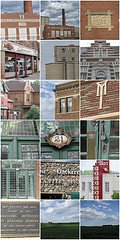
Minneapolis - My visit to the Weisman Art Museum, University of MN, last week purposely coincided with the opening of its new exhibit, By the People, For the People: New Deal Art and a lecture by Erica Doss. Ms. Doss is chair of the Department of American Studies at the University of Notre Dame and "a leading historian of American art and visual culture" according to the Weisman's web site.
Ms. Doss began her talk entitled Picturing New Deal America: The Visual Arts and National Identity, 1933-1945, by explaining how the WPA (Works Progress Administration) was organized. She quickly toggled among the screens of her Mac driven media show and discussed works and artists that were likely new to many. The audience remained silently engaged with ears perked toward the front of the high-ceilinged lecture hall. The audience questions were perfect - as if written into the script. "Who owns this art?" "What happened to the art when the program was cut?" "Could we have another WPA program today?"

I had never considered the New Deal or the WPA a subject of interest. But this art history was truly fascinating. You might relate WPA art to the stunning photography that helped make Dorothea Lange famous, Migrant Mother, 1936. But the WPA was so much more. It was a time for real artists to reach the masses. It was art by the people and for the people instead of art for the elite alone. Works ranged from films, graphic arts, posters, sculptures, and easel paintings to U.S post office murals. Not every artist supported the New Deal ideals and some of the pieces conveyed this, whether stylized or abstract.
Some of the art served as helpful propaganda for the FDR administration as well. These visual stories, imbued with the era's ideal norms, purported icons of intelligent working boss men, brawny male laborers and wholesome women. I wonder how artists might re-create their work today? Mama might be wielding the hammer, and Daddy, the apron.
Today many museums own WPA art simply because it got left behind when programs were cut in 1945. According to Ms. Doss, WPA art was literally thrown out by the U.S. government branches that housed the many programs. Fortunately much of it was also auctioned off in large bales and consequently bought up by art dealers. By the 1960s, many of them had started to sell off their WPA collections. Along the way, some artists sold their work directly into the hands of the people.

Dewey Albinson was one of many American painters who produced a range of work for the WPA. His subject matter included some Minneapolis scenes, two of which are on display in the Minnesota section of By the People, For the People. Mr. Albinson's style owns refreshing colors and quick brush strokes, as seen in "Bohemian Flats", 1934. This easel oil painting on canvas, commissioned by the University of MN, features Minneapolis's poor Bohemian artist and immigrant quarters. The city had been trying to move this community off of its Mississippi river front locale for years.
Three more of Mr. Albinson's paintings are on permanent display at the Minneapolis American Swedish Institute. ASI Curator, Curt Pederson, says a Dewey Albinson retrospective is on schedule for April 2009. "It will feature paintings and drawings from the private collection of Dewey's family; son, daughter, nephew." The Walker Art Center, Minneapolis, also holds a WPA collection. The Weisman will be hosting a Walker guest lecture in June.

If you're looking, WPA art is accessible all across America today. Kudos to the Weisman for pulling its collection out of storage and giving it a lot of fresh air. More kudos to the Weisman for curating a cohesive exhibit theme on such an extensive subject. If the busy opening party, well-attended lecture and the full parking ramp are indicators of the potential interest in this subject, I foresee a very busy run for By the People, For the People.
Photos copyright 2008 by SAS, except Migrant Mother, 1936 which is public domain.





No comments:
Post a Comment